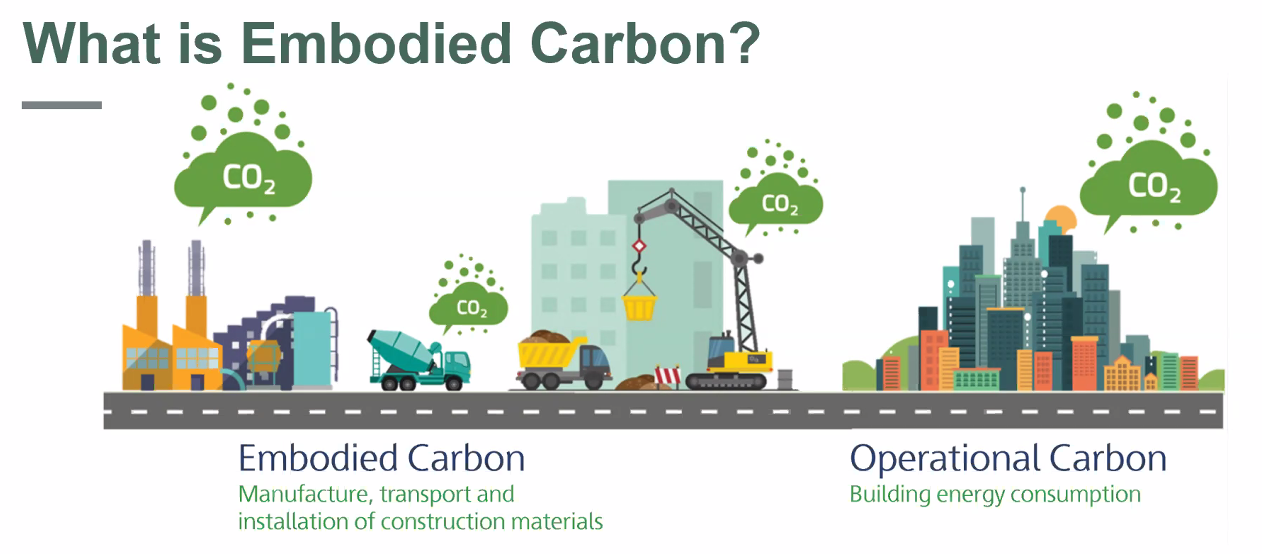contact us
If you have questions, feel free to get in touch.
Address
200-2414 St Johns St,
Port Moody, BC, V3H 2B1
Hours
Monday — Friday: 8 AM - 4 PM, PST
Contacts
HAVE A QUESTION? ASK OUR EXPERTS
Understanding Embodied Carbon The Hidden Impact of Construction and Manufacturing
2025, January 1

We have seen increase focus Globally on sustainability, carbon emissions, typically associated with Operational Carbon. As seen in the building industry with the adoption of product environmental certifications EPD and broader LEED building environmental certification.
However, there exists another, less conspicuous source of carbon emissions that significantly contributes to our environmental footprint: Embodied Carbon.
It is important for the construction sector to consider the hidden impact of Embodied Carbon, to best navigate the environmental impact, and government regulations.
Embodied Carbon refers to the total greenhouse gas emissions associated with:
It encompasses the carbon dioxide (CO2) emissions released throughout a product’s entire lifecycle, from raw material extraction to disposal at the end of its useful life. While operational carbon emissions from buildings and infrastructure have traditionally been the primary focus of sustainability efforts, the significance of embodied carbon cannot be overlooked.
The construction and manufacturing industries are major contributors to global carbon emissions. Concrete, steel, aluminum, and plastics—materials commonly used in construction and manufacturing—are particularly carbon-intensive to produce. The process of extracting raw materials, such as mining limestone for cement or extracting iron ore for steel production, often involves energy-intensive processes that release substantial amounts of CO2 into the atmosphere.
Furthermore, the transportation of these materials from manufacturing facilities to construction sites adds to their embodied carbon footprint. Whether transported locally or internationally, the logistics of moving heavy materials contribute to additional emissions, especially if fossil fuels power the transportation.
The cumulative impact of embodied carbon becomes evident when considering the scale of construction projects and the lifespan of buildings and infrastructure. Even though a building may eventually operate on renewable energy or achieve high energy efficiency standards, the emissions embedded in its construction can outweigh the emissions it saves during its operational phase over time.
Recognizing the significance of embodied carbon, architects, engineers, and policymakers are increasingly focusing on strategies to mitigate its impact. Several approaches can be employed to reduce embodied carbon throughout the lifecycle of buildings and infrastructure:

Governments and industry bodies play a crucial role in driving the adoption of practices that address embodied carbon. Through building codes, regulations, and incentives, policymakers can encourage the use of low-carbon materials and promote sustainable construction practices.
Furthermore, industry initiatives such as the Architecture 2030 Challenge and the Embodied Carbon in Construction Calculator (EC3) provide tools and frameworks to assess and mitigate embodied carbon in construction projects.
As the urgency to combat climate change intensifies, addressing embodied carbon must become a priority for the construction and manufacturing sectors. By adopting sustainable practices, leveraging innovative technologies, and collaborating across industries, we can significantly reduce the environmental impact of our built environment.
Ultimately, a holistic approach that considers both operational and embodied carbon emissions is essential for achieving carbon neutrality and building a more sustainable future. Through collective action and concerted efforts, we can mitigate the hidden impact of embodied carbon and pave the way towards a more resilient and environmentally responsible built environment.
Contact Greenlite Glass Systems today to discuss your project requirements and discover how our fire-rated skylights can elevate your building design to new heights!
Phone: (778) 285-8530
Email: [email protected]
contact us
If you have questions, feel free to get in touch.
Address
200-2414 St Johns St,
Port Moody, BC, V3H 2B1
Hours
Monday — Friday: 8 AM - 4 PM, PST
Contacts
HAVE A QUESTION? ASK OUR EXPERTS
Thank you for your interest!
We will contact you shortly.THANK YOU FOR SUBSCRIBING!